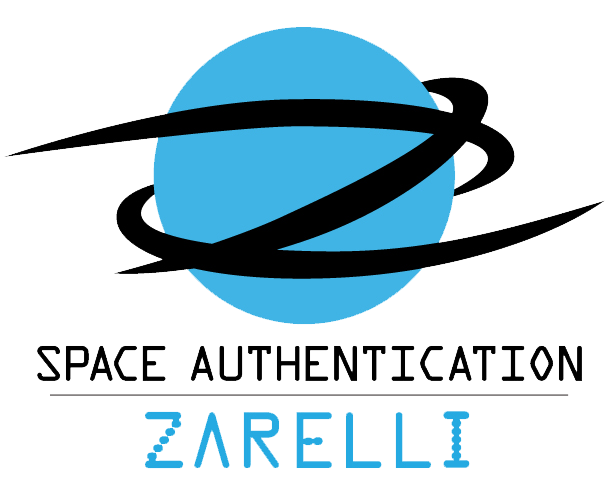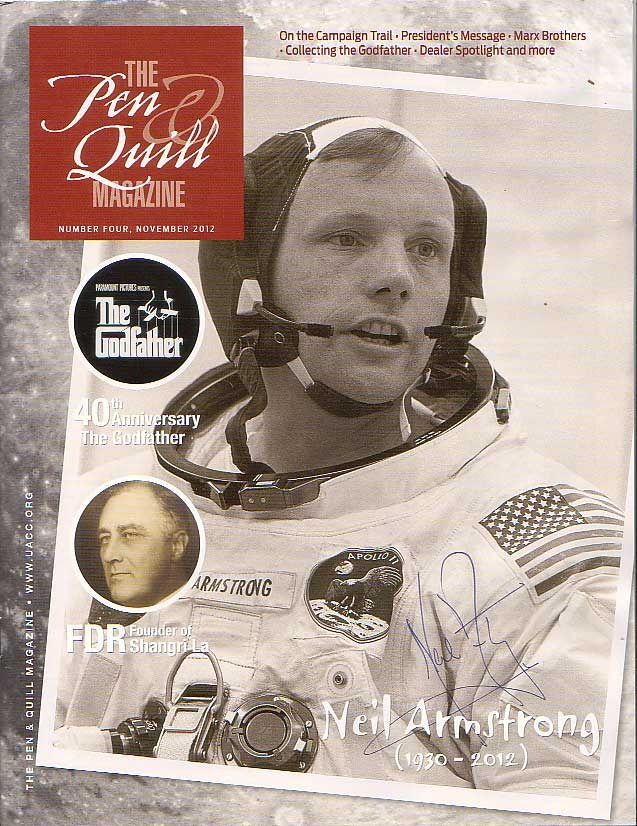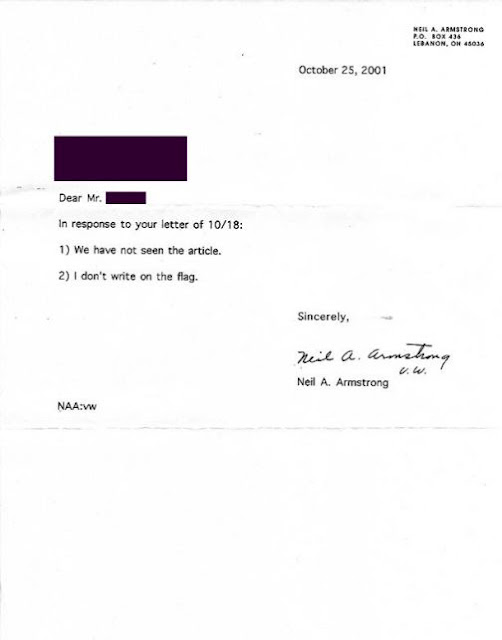It was 10 years ago that I publicly presented the Neil Armstrong Flag Test -- a litmus test to help detect some Neil Armstrong forgeries. In honor of the 10th anniversary, I reprint my web entry from 10 years ago (from my old Geocities web site, which has been defunct for some time.)
#######
Original Article - 3/11/2001
Most experienced autograph collectors know that signature placement can be a key clue to help determine authenticity. While sometimes signature formation may be debatable, the signature placement is an additional tip-off that there may be an authenticity problem. This doesn't apply to all - or even most - celebrities. But there are certain celebrities that demonstrate very consistent signature placement patterns... and savvy collectors should pay great attention to such habits. Neil Armstrong is one celebrity with a very specific signing habit.
Down And To The Right
Neil Armstrong has signed tens of thousands of NASA White Space Suit (WSS) portraits in the past 30 years. The vast majority of these are inscribed. Armstrong typically signed with his infamous fading blue marker, with the signature located near his left elbow. It's no secret in the collecting community that he usually signed in this area. So, for years I used this as a general guideline as to where his signature should be. It was only recently that I made the connection as to where his signature shouldn't be.
Don't Tread On Me
I was recently chatting online with another collector who had asked me to take a look at a couple of Armstrong WSS signed photos. I make no claim to be an expert in the signature of Neil Armstrong. However, after getting burned with a forgery a couple of years back, I've made it my mission to study his signature closely and learn his characteristics. So, I feel comfortable offering an informal opinion in some cases.
The signatures the collector showed me appeared to be forgeries. There were several atypical formation characteristics plus unusually high signature placement. After detailing the unusual characteristics, I said, "Also, this signature is touching the flag patch on his shoulder, that means it's too high." I had always used the flag as a boundary to know when a signature was wandering too far from its typical placement.
Then referring to another (authentic) example, he responded, "That's funny, the inscription doesn't go near the flag either."
Then it clicked.
Armstrong doesn't write on the flag!
The flag patch area was more than just a "boundary", it was sacred ground not to be written over.
Confirming the Theory
"Could it be this simple?", I asked myself. I frantically searched through every authentic exemplar I could find. Sure enough, I couldn't find one where his handwriting went over the flag patch area. In cases with unusually long inscriptions, the odd line spacing indicates that he intentionally avoided writing over the flag area!
The next morning I contacted some friends with my findings. I asked them to review the theory and see if it sticks. Among the friends I contacted were such renowned collectors as Al Hallonquist, Gerry Montague, Russ Still, Bobby McLeod, Mike Joner, Rick Cigel, Ken Havekotte and Donnis Willis. Together, we searched our personal archives, past auction catalogs, and online sources. In all, we examined over 100 Armstrong WSS portraits. The flag theory was 100% accurate. In a few cases, his writing may slightly brush the outer perimeter of the flag, but it never intruded into the interior of the flag.
There were several cases where the Armstrong's writing was over the flag patch area. But, in every one of these cases, it was a signature that had been previously marked as suspicious before we even conceived the flag test. (Figures 4 and 5)

Forgery - writing over flag

Forgery - writing over flag
Ironically, after presenting the theory, I learned that Mike Joner had independently arrived at the same flag conclusion as I did based on a previous conversation we had about Armstrong signature placement.
Intentional or Coincidence?
I submit that Armstrong intentionally avoids writing on the flag, and it is not just a coincidence. Here is why:

When the entire inscription fits to the left or below the flag area there is a "normal" amount of space between the two lines. (Figure 2)

When there is a long 2 line inscription, the inscription is placed so the first line runs over the top of the flag, and the second line runs below the flag. The two lines are widely spaced to avoid the inscription running into the flag. What other reason could there be for the unusual line spacing that is only observed with lengthy inscriptions? (Figure 1)
An Effective Authentication Technique
Given the sample size and the 100% accuracy thus far, the flag test is a highly effective authentication technique. Even if an undoubtedly authentic exemplar came to light where there is writing on the flag, it does not nullify the flag test. It would still be safe to say that the flag test would be accurate in the vast majority of cases.
Caveat Emptor
Neil Armstrong's autograph is one of the most widely forged autographs. In many cases, simple signature analysis will weed out non-authentic material. Unfortunately, there are many deceptive forgeries in existence.
Luckily, many of the better forgeries fail the flag test. This is a simple test that someone with no signature analysis skill can apply. Also, bear in mind that uninscribed WSS are rare, and almost all the Flag Test failures we found were uninscribed. This further supports the fact that the Flag Test does weed out suspect exemplars.
Of course, unless we examined every Armstrong WSS in existence, we cannot say this theory will hold true 100%. However, given the findings thus far, any WSS with writing or signature over the flag should be viewed with great skepticism.
Credits
Article by Steve Zarelli. The following fine people contributed and made this theory possible: Rick Cigel, Al Hallonquist, Ken Havekotte, Mike Joner, Bobby McLeod, Gerry Montague, Russ Still, John Wardell and Donnis Willis.
#######
Update - 12/2/2001 - Armstrong Verifies Test
A collector recently send me a photocopy of a response he received from Armstrong's office. In short, Armstrong verifies the Flag Test by stating "I don't write on the flag." The collector wishes to remain anonymous, so his name has been blacked out.

















 Even though Buzz Aldrin is a common signature, his signing fee is high (around $400 last time I checked). Apparently, he still gets people to pay the fee. A common signed Aldrin item might command $100 - $150 on ebay.
Even though Buzz Aldrin is a common signature, his signing fee is high (around $400 last time I checked). Apparently, he still gets people to pay the fee. A common signed Aldrin item might command $100 - $150 on ebay. Mike Collins used to be the most uncommon signature among the Apollo 11 crew. He signed freely for a few years after Apollo 11 until the mid-70s when he worked at the Smithsonian. After that, he became more reclusive; he didn't hide his dislike for autograph requests. In recent years, he has conducted private signings and appeared at a few signing events. Still, his signature is in high demand.
Mike Collins used to be the most uncommon signature among the Apollo 11 crew. He signed freely for a few years after Apollo 11 until the mid-70s when he worked at the Smithsonian. After that, he became more reclusive; he didn't hide his dislike for autograph requests. In recent years, he has conducted private signings and appeared at a few signing events. Still, his signature is in high demand. A signed Apollo 11 crew photo is one of the holy grails of astronaut autograph collecting, commanding thousands of dollars. While I'd love to have one in my collection, I think there is a higher probability of me being the next man to walk on the moon!
A signed Apollo 11 crew photo is one of the holy grails of astronaut autograph collecting, commanding thousands of dollars. While I'd love to have one in my collection, I think there is a higher probability of me being the next man to walk on the moon!